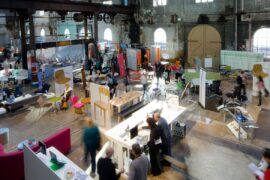What is interior design’s responsibility in revolutionising aged-care environments? The new Emmy Monash Aged-Care facility in Melbourne’s Caufield has all the luxury commodities of a contemporary multi-residential complex. From thoughtfully considered finishes through to superior shared facilities, no expense has been spared on residents’ comfort and quality of life.
Community-based organisation Emmy Monash Aged-Care commissioned Bates Smart to bring its experience in healthcare, residential and hospitality design to create “superior” residential aged-care for Melbourne’s Jewish community.
“Our biggest driving desire was to deinstitutionalise the clinical nature of the functional requirements of an aged-care facility,” says Bates Smart’s interior design director Jeffery Copolov.
That started by orientating the building to allow natural light penetration deep into the “figure of eight plan”, and positioning each of the 97 low-and high-dependency residential rooms around the perimeter and the two internal courtyards. Maintaining resident contact with natural light, nature or planting at any point in time on any of the four residential levels “improves the sense of wellbeing”, explains Copolov. “It gives an understanding of light and day, the seasons and the passing of time.”
Interior spaces are deliberately youthful. “We didn’t want a place full of floral or to stereotype seniors by making interiors that look old world – these people enjoy contemporary art and theatre,” implores Copolov. The modern design of the custom made furniture goes above and beyond the standard pragmatic needs of firmness, armrests, short seats and upright backs, as does the extra step of collaborating with suppliers to redesign the colourways of the mandatory protection materials.
Another disruptor to the aged-care norm is the hospitality driven idea of ensuring that food is freshly plated in servery kitchens. They are located next to intimate, communal dining rooms on each level and connected to a principal basement kitchen. And instead of being a tucked-away service, an authentic beauty salon is prominently located adjacent to a high street style café on the ground floor. The likes of these amenities along with cosy communal lounges set around fireplaces, serene secondary seating areas, a library, cinema, music therapy and activities rooms, all help to foster “community, conversation and social stimulation”, Copolov says.
For visitors there’s the additional considerations of being able to share a “real” coffee, attend a family celebration in a bookable private dining room, participate in regular synagogue services or simply enjoy the provision of ample seating for in-room catch-ups.
Gandel House has undoubtedly been completed to a high standard, “but nonetheless, a stringent budget still applied”, says Copolov of the use of proprietary black aluminium window frames; easy clean and replaceable proprietary carpet tiles and the panelised plasterboard walls “strapped” with MDF. This wall design detailing was driven by the use of a proprietary plastic extrusion for the bumper bars, which Bates Smart reverse-engineered in place of the common retro-fitted options. Grab rails were also designed “to look as residential and architectural as possible” and fitted with custom style powder coated steel brackets.
From varying table settings to denote different meal times, to minimising the impact of signage, lining walls with art hanging rails, and generous private storage, here it’s about “care, thought and good design” – exploring “how to make the experience fuller as you might at home”. That’s strongly expressed by the unique sense of personal address of each individual residence – signified by a change of bulkhead, a generous timber veneer front door, transitioning of the floor finish, a light fitting and a memory box for displaying personalised photos and objects.
“Yes there is a need for a budget to provide the diversity of amenities and space, and some budgets will be more generous than others,” Copolov concedes of the 50 million dollar budget. “But you also need to have a client who is seeking it, an architect who is pushing for it and a common desire to achieve it,” he asserts. “I think the greatest contribution that we as designers can make is when we raise the bar and it’s our job to do so by questioning every aspect of a brief.” It’s projects like Gandel House at Emmy Monash that can help to lift market expectations in aged-care and pull the rest of the sector along.
See other projects by Bates Smart here. And for regular design inspiration, sign up for our newsletter here.
INDESIGN is on instagram
Follow @indesignlive
A searchable and comprehensive guide for specifying leading products and their suppliers
Keep up to date with the latest and greatest from our industry BFF's!

In this candid interview, the culinary mastermind behind Singapore’s Nouri and Appetite talks about food as an act of human connection that transcends borders and accolades, the crucial role of technology in preserving its unifying power, and finding a kindred spirit in Gaggenau’s reverence for tradition and relentless pursuit of innovation.

Within the intimate confines of compact living, where space is at a premium, efficiency is critical and dining out often trumps home cooking, Gaggenau’s 400 Series Culinary Drawer proves that limited space can, in fact, unlock unlimited culinary possibilities.

Saturday Indesign is one of the standout fixtures on the Asia-Pacific design calendar – but how exactly did it start, and when did it become so big?

What a week! With so many events still to come, Jan Henderson gives us a taste of what the 2025 edition has been like so far.
The internet never sleeps! Here's the stuff you might have missed

Stephen McGarry redefines architecture as an emotive and contextual artform, blending storytelling, material sensitivity, and cultural memory in his shortlisted Bruce Street project.

Healthcare design expert Tracy Lord joins us on the Stories Indesign podcast to discuss her varied inspiration and the need for nuance in her sector.